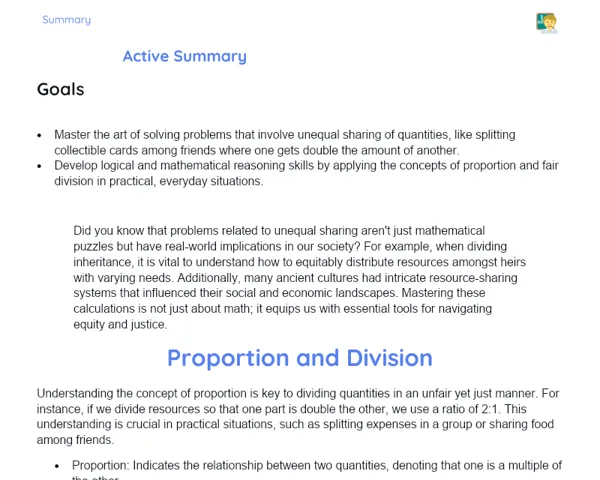Summary Tradisional | Function: Inputs and Outputs
Contextualization
A function is a mathematical relationship that connects each element of a set of inputs to exactly one element of a set of outputs. This concept is fundamental in mathematics and various other fields, as it helps us model and understand behaviors and patterns in different systems. For instance, by inputting a specific value into a function, we can predict the outcome, which is crucial in areas like engineering, economics, and computer science.
To grasp how a function operates, we can think of it like a machine that takes an input number and delivers an output number. If this machine is designed to add 2 to any number you provide, entering the number 3 will give you 5. This straightforward example illustrates the function's operation, helping us visualize the connection between inputs and outputs. Understanding this relationship is vital for tackling practical and theoretical problems that involve calculations and predictions.
To Remember!
Definition of Function
A function is a relationship between two sets, where each element of the first set (input) corresponds uniquely to one element in the second set (output). This relationship can be represented in various forms, including tables, graphs, and equations. The key feature of a function is that each input correlates with a single output.
In mathematics, a function is usually denoted as f(x), where x signifies the function's input and f(x) denotes the output. For example, in the function f(x) = x + 2, if we enter the value 3 for x, the output will be 5. This notation is essential for clear communication of mathematical relationships.
Grasping the definition of a function is fundamental for advanced mathematics studies, as numerous mathematical concepts and operations depend on this basic understanding. From solving equations to modeling real-life scenarios, the idea of a function is a powerful asset.
-
A function is a relationship between two sets.
-
Each input has a unique corresponding output.
-
Functions can be represented through tables, graphs, and mathematical expressions.
Function Notation
Function notation is a formal way of showcasing the relationship between inputs and outputs. The most common notation is f(x), where f stands for the function and x is the independent variable or input. For example, the notation f(x) = x + 2 means that the function adds 2 to whatever value x takes.
This notation is incredibly useful, as it allows for clear and precise communication of mathematical relationships. Furthermore, it aids in manipulating and resolving functions in both algebraic and graphical contexts. Function notation is also vital for comprehending more complex concepts, like derivatives and integrals, which are key in calculus and mathematical analysis.
Learning how to read and interpret function notation is an essential step in overcoming mathematical challenges. This skill enables students to seamlessly navigate between various representations of functions and apply their understanding to a wide array of practical and theoretical scenarios.
-
Function notation formalizes the relationship between inputs and outputs.
-
f(x) is the most prevalent form of function notation.
-
It fosters clear and precise communication of mathematical relationships.
Domain and Range
The domain of a function refers to the set of all permissible inputs for the function. Simply put, it encompasses all values that x can take in the expression f(x). For instance, if f(x) = 1/x, the domain excludes x = 0, since division by zero is undefined. Knowing the domain is crucial to avoid values that might make the function undefined or non-real.
Conversely, the range of a function represents the set of all possible outputs. It consists of the values that f(x) can assume as x varies within its domain. Continuing with our earlier example, if f(x) = 1/x, the range will include all real numbers except 0, because 1/x cannot equal zero.
Understanding the concepts of domain and range is pivotal for analyzing functions, as it helps in identifying which input values are valid and predicting the outputs of the function. This knowledge is crucial for problem-solving and accurately graphing functions.
-
The domain is the set of all possible inputs of a function.
-
The range is the set of all possible outputs of a function.
-
Understanding domain and range is critical for avoiding undefined values and for analyzing functions.
Linear Function
A linear function is one whose algebraic expression appears in the form f(x) = mx + b, where m and b are constants. Here, m indicates the slope or gradient of the line, while b describes the y-intercept. Linear functions are termed so because, when plotted, they form a straight line.
The slope m indicates how steep the function is. If m is positive, the line inclines as x increases; if m is negative, the line declines. The intercept b shows where the line meets the y-axis. Understanding how these two parameters influence the graph's shape is essential for interpreting and creating linear function graphs.
Linear functions are widely applicable in many fields such as economics, physics, and engineering, where they model direct relationships between two variables. For instance, the relationship between distance and time at a constant speed constitutes a linear function. Therefore, understanding linear functions is a significant stepping stone for solving both practical and theoretical issues across various disciplines.
-
A linear function can be expressed as f(x) = mx + b.
-
The slope m signifies the rate of change of the function.
-
The intercept b indicates where the line intersects the y-axis.
Key Terms
-
Function: A relationship between two sets where each input has a unique corresponding output.
-
Function Notation: A formal way of representing mathematical relationships using f(x).
-
Domain: The set of all permissible inputs of a function.
-
Range: The set of all possible outputs of a function.
-
Linear Function: A function represented as f(x) = mx + b, where m is the slope and b is the intercept.
Important Conclusions
In this lesson, we delved into the concept of functions, focusing on the mathematical relationship between inputs and outputs. We learned how a function links each input to exactly one output and explored how this relationship can be depicted through algebraic notation, tables, and graphs. Additionally, we covered essential concepts such as domain and range, which are vital for analyzing and resolving functional problems.
We also examined linear functions, which represent one of the simplest and most practical forms of functions. We understood how the slope and intercept influence the graph's shape and positioning, and discussed their applications in diverse areas like economics and physics. Solving real-world problems solidified these concepts, enabling a direct application of the theoretical knowledge.
Grasping the concept of functions is crucial not only for mathematics but also for various other fields and everyday situations. Knowing how to calculate inputs and outputs of functions is a fundamental skill that supports solving complex problems and modeling real-world scenarios. I encourage everyone to further explore this subject, as the mathematics of functions provides deeper insights into understanding the world around us.
Study Tips
-
Review the examples and problems discussed in class to strengthen your understanding of calculating inputs and outputs of functions.
-
Practice solving various types of functions, such as linear and quadratic ones, to gain confidence in applying the concepts.
-
Utilize further resources, including educational videos and online exercises, to deepen your grasp of functions and their practical uses.



